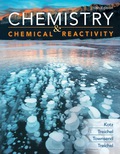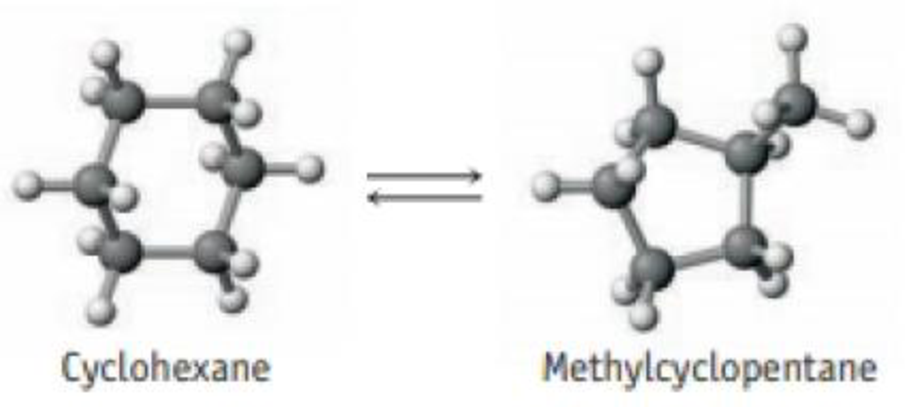
Chemistry & Chemical Reactivity
10th Edition
ISBN: 9781337670418
Author: Kotz
Publisher: Cengage
expand_more
expand_more
format_list_bulleted
Textbook Question
Chapter 15, Problem 14PS
Cyclohexane, C6H12, a hydrocarbon, can isomerize or change into methylcyclopentane, a compound of the same formula (C5H9CH3) but with a different molecular structure.
 sssss
sssss
The equilibrium constant has been estimated to be 0.12 at 25 °C. If you had originally placed 0.045 mol of cyclohexane in a 2.8-L flask, what would be the concentrations of cyclohexane and methylcyclopentane when equilibrium is established?
Expert Solution & Answer
Trending nowThis is a popular solution!

Students have asked these similar questions
Q4: Rank the relative nucleophilicity of halide ions in water solution and DMF solution,
respectively.
F CI
Br |
Q5: Determine which of the substrates will and will not react with NaSCH3 in an SN2 reaction to
have a reasonable yield of product.
NH2
Br
Br
Br
OH
Br
Q7: Rank the following groups in order of basicity, nucleophilicity, and leaving group ability.
a) H₂O, OH, CH3COOT
b) NH3, H₂O, H₂S
Q8: Rank the following compounds in order of increasing reactivity in a nucleophilic substitution
reaction with CN as the nucleophile.
Br
A
B
NH2
LL
F
C
D
OH
CI
LLI
E
Q9: Complete the missing entities for following reactions (e.g., major product(s), reactants,
and/or solvents) for the SN2 reactions to occur efficiently. Include curved-arrow mechanism for
reactions a) to d).
a)
H
"Cl
D
+
-OCH 3
Page 3 of 5
Chapter 15 Solutions
Chemistry & Chemical Reactivity
Ch. 15.2 - Write the equilibrium constant expression for each...Ch. 15.2 - Answer the following questions regarding the...Ch. 15.3 - A solution is prepared by dissolving 0.050 mol of...Ch. 15.4 - At some temperature. Kc = 33 for the reaction...Ch. 15.4 - The decomposition of PCl5(g) to form PCl3(g) and...Ch. 15.5 - The conversion of oxygen to ozone has a very small...Ch. 15.6 - Equilibrium exists between butane and isobutane...Ch. 15.6 - Anhydrous ammonia is used directly as a...Ch. 15.6 - Prob. 1.2ACPCh. 15.6 - Freezing point depression is one means of...
Ch. 15.6 - Prob. 2.2ACPCh. 15.6 - A 0.64 g sample of the white crystalline dimer (4)...Ch. 15.6 - Predict whether the dissociation of the dimer to...Ch. 15.6 - Prob. 2.5ACPCh. 15 - Write equilibrium constant expressions for the...Ch. 15 - Write equilibrium constant expressions for the...Ch. 15 - Kc = 5.6 1012 at 500 K for the dissociation of...Ch. 15 - The reaction 2 NO2(g) N2O4(g) has an equilibrium...Ch. 15 - A mixture of SO2, O2, and SO3 at 1000 K contains...Ch. 15 - The equilibrium constant Kc, for the reaction 2...Ch. 15 - The reaction PCl5(g) PCl3(g) + Cl2(g) was...Ch. 15 - An equilibrium mixture of SO2, O2, and SO3 at a...Ch. 15 - The reaction C(s) + CO2(g) 2 CO(g) occurs at high...Ch. 15 - Hydrogen and carbon dioxide react at a high...Ch. 15 - A mixture of CO and Cl2 is placed in a reaction...Ch. 15 - You place 0.0300 mol of pure SO3 in an 8.00-L...Ch. 15 - The value of Kc for the interconversion of butane...Ch. 15 - Cyclohexane, C6H12, a hydrocarbon, can isomerize...Ch. 15 - The equilibrium constant for the dissociation of...Ch. 15 - The equilibrium constant, Kc, for the reaction...Ch. 15 - Carbonyl bromide decomposes to carbon monoxide and...Ch. 15 - Iodine dissolves in water, but its solubility in a...Ch. 15 - Which of the following correctly relates the...Ch. 15 - Which of the following correctly relates the...Ch. 15 - Consider the following equilibria involving SO2(g)...Ch. 15 - The equilibrium constant K for the reaction CO2(g)...Ch. 15 - Calculate K for the reaction SnO2(s) + 2 CO(g) ...Ch. 15 - Calculate K for the reaction Fe(s) + H2O(g) ...Ch. 15 - Relationship of Kc and Kp: (a) Kp for the...Ch. 15 - Relationship of Kc and Kp: (a) The equilibrium...Ch. 15 - Dinitrogen trioxide decomposes to NO and NO2, in...Ch. 15 - Kp for the following reaction is 0.16 at 25 C: 2...Ch. 15 - Consider the isomerization of butane with an...Ch. 15 - The decomposition of NH4HS NH4HS(s) NH3(g) +...Ch. 15 - Suppose 0.086 mol of Br2 is placed in a 1.26-L...Ch. 15 - The equilibrium constant for the reaction N2(g) +...Ch. 15 - Kp for the formation of phosgene, COCl2, is 6.5 ...Ch. 15 - The equilibrium constant, Kc, for the following...Ch. 15 - Carbon tetrachloride can be produced by the...Ch. 15 - Equal numbers of moles of H2 gas and I2 vapor are...Ch. 15 - The equilibrium constant for the butane isobutane...Ch. 15 - At 2300 K the equilibrium constant for the...Ch. 15 - Which of the following correctly relates the two...Ch. 15 - Consider the following equilibrium: COBr2(g) ...Ch. 15 - Heating a metal carbonate leads to decomposition....Ch. 15 - Phosphorus pentachloride decomposes at elevated...Ch. 15 - Ammonium hydrogen sulfide decomposes on heating....Ch. 15 - Ammonium iodide dissociates reversibly to ammonia...Ch. 15 - When solid ammonium carbamate sublimes, it...Ch. 15 - In the gas phase, acetic acid exists as an...Ch. 15 - Assume 3.60 mol of ammonia is placed in a 2.00-L...Ch. 15 - The total pressure for a mixture of N2O4 and NO2...Ch. 15 - Kc for the decomposition of ammonium hydrogen...Ch. 15 - Prob. 52GQCh. 15 - A 15-L flask at 300 K contains 6.44 g of a mixture...Ch. 15 - Lanthanum oxalate decomposes when heated to...Ch. 15 - The reaction of hydrogen and iodine to give...Ch. 15 - Sulfuryl chloride, SO2Cl2 is used as a reagent in...Ch. 15 - Hemoglobin (Hb) can form a complex with both O2...Ch. 15 - Limestone decomposes at high temperatures....Ch. 15 - At 1800 K, oxygen dissociates very slightly into...Ch. 15 - Nitrosyl bromide, NOBr, dissociates readily at...Ch. 15 - A Boric acid and glycerin form a complex...Ch. 15 - The dissociation of calcium carbonate has an...Ch. 15 - A sample of N2O4 gas with a pressure of 1.00 atm...Ch. 15 - Prob. 64GQCh. 15 - The photograph below shows what occurs when a...Ch. 15 - The photographs below (a) show what occurs when a...Ch. 15 - Decide whether each of the following statements is...Ch. 15 - Neither PbCl2 nor PbF2 is appreciably soluble in...Ch. 15 - Characterize each of the following as product- or...Ch. 15 - The size of a flask containing colorless N2O4(g)...Ch. 15 - Describe an experiment that would allow you to...Ch. 15 - The chapter opening photograph (page 670) showed...Ch. 15 - Suppose a tank initially contains H2S at a...Ch. 15 - Pure PCl5 gas is placed in a 2.00-L flask. After...
Additional Science Textbook Solutions
Find more solutions based on key concepts
Describe Mendels conclusions about how traits are passed from generation to generation.
Concepts of Genetics (12th Edition)
An obese 55-year-old woman consults her physician about minor chest pains during exercise. Explain the physicia...
Biology: Life on Earth with Physiology (11th Edition)
Choose the best answer to each of the following. Explain your reasoning. If Earth were twice as far as it actua...
Cosmic Perspective Fundamentals
To test your knowledge, discuss the following topics with a study partner or in writing ideally from memory. Th...
HUMAN ANATOMY
Label each statement about the polynucleotide ATGGCG as true or false. The polynucleotide has six nucleotides. ...
General, Organic, and Biological Chemistry - 4th edition
6. How can you use the features found in each chapter?
Human Anatomy & Physiology (2nd Edition)
Knowledge Booster
Learn more about
Need a deep-dive on the concept behind this application? Look no further. Learn more about this topic, chemistry and related others by exploring similar questions and additional content below.Similar questions
- Q10: (a) Propose a synthesis of C from A. (b) Propose a synthesis of C from B. Br Br ...\SCH 3 A B Carrow_forward9: Complete the missing entities for following reactions (e.g., major product(s), reactants, and/or solvents) for the SN2 reactions to occur efficiently. Include curved-arrow mechanism for reactions a) to d).arrow_forwardComplete the missing entities for following reactions (e.g., major product(s), reactants, and/or solvents) for the SN2 reactions to occur efficiently. Include curved-arrow mechanism for reactions a) to d).arrow_forward
- QUESTION 3: Provide the synthetic steps that convert the starting material into the product (no mechanism required). HO OH NH CH3 multiple steps 요요 H3Carrow_forwardQ6: Predict the effect of the changes given on the rate of the reaction below. CH3OH CH3Cl + NaOCH3 → CH3OCH3 + NaCl a) Change the substrate from CH3CI to CH31: b) Change the nucleophile from NaOCH 3 to NaSCH3: c) Change the substrate from CH3CI to (CH3)2CHCI: d) Change the solvent from CH3OH to DMSO.arrow_forwardQ3: Arrange each group of compounds from fastest SN2 reaction rate to slowest SN2 reaction rate. a) CI Cl فيكم H3C-Cl A B C D Br Br b) A B C Br H3C-Br Darrow_forward
- Q2: Group these solvents into either protic solvents or aprotic solvents. Acetonitrile (CH3CN), H₂O, Acetic acid (CH3COOH), Acetone (CH3COCH3), CH3CH2OH, DMSO (CH3SOCH3), DMF (HCON(CH3)2), CH3OHarrow_forwardSuppose the rate of evaporation in a hot, dry region is 1.76 meters per year, and the seawater there has a salinity of 35 ‰. Assuming a 93% yield, how much salt (NaCl) can be harvested each year from 1 km2 of solar evaporation ponds that use this seawater as a source?arrow_forwardhelparrow_forward
- Explain why only the lone pairs on the central atom are taken into consideration when predicting molecular shapearrow_forward(ME EX1) Prblm #9/10 Can you explain in detail (step by step) I'm so confused with these problems. For turmber 13 can u turn them into lewis dot structures so I can better understand because, and then as well explain the resonance structure part. Thanks for the help.arrow_forwardProblems 19 and 20: (ME EX1) Can you please explain the following in detail? I'm having trouble understanding them. Both problems are difficult for me to explain in detail, so please include the drawings and answers.arrow_forward
arrow_back_ios
SEE MORE QUESTIONS
arrow_forward_ios
Recommended textbooks for you
 Chemistry & Chemical ReactivityChemistryISBN:9781337399074Author:John C. Kotz, Paul M. Treichel, John Townsend, David TreichelPublisher:Cengage Learning
Chemistry & Chemical ReactivityChemistryISBN:9781337399074Author:John C. Kotz, Paul M. Treichel, John Townsend, David TreichelPublisher:Cengage Learning Chemistry & Chemical ReactivityChemistryISBN:9781133949640Author:John C. Kotz, Paul M. Treichel, John Townsend, David TreichelPublisher:Cengage LearningChemistry: Matter and ChangeChemistryISBN:9780078746376Author:Dinah Zike, Laurel Dingrando, Nicholas Hainen, Cheryl WistromPublisher:Glencoe/McGraw-Hill School Pub Co
Chemistry & Chemical ReactivityChemistryISBN:9781133949640Author:John C. Kotz, Paul M. Treichel, John Townsend, David TreichelPublisher:Cengage LearningChemistry: Matter and ChangeChemistryISBN:9780078746376Author:Dinah Zike, Laurel Dingrando, Nicholas Hainen, Cheryl WistromPublisher:Glencoe/McGraw-Hill School Pub Co General Chemistry - Standalone book (MindTap Cour...ChemistryISBN:9781305580343Author:Steven D. Gammon, Ebbing, Darrell Ebbing, Steven D., Darrell; Gammon, Darrell Ebbing; Steven D. Gammon, Darrell D.; Gammon, Ebbing; Steven D. Gammon; DarrellPublisher:Cengage Learning
General Chemistry - Standalone book (MindTap Cour...ChemistryISBN:9781305580343Author:Steven D. Gammon, Ebbing, Darrell Ebbing, Steven D., Darrell; Gammon, Darrell Ebbing; Steven D. Gammon, Darrell D.; Gammon, Ebbing; Steven D. Gammon; DarrellPublisher:Cengage Learning Chemistry: The Molecular ScienceChemistryISBN:9781285199047Author:John W. Moore, Conrad L. StanitskiPublisher:Cengage Learning
Chemistry: The Molecular ScienceChemistryISBN:9781285199047Author:John W. Moore, Conrad L. StanitskiPublisher:Cengage Learning Chemistry: Principles and PracticeChemistryISBN:9780534420123Author:Daniel L. Reger, Scott R. Goode, David W. Ball, Edward MercerPublisher:Cengage Learning
Chemistry: Principles and PracticeChemistryISBN:9780534420123Author:Daniel L. Reger, Scott R. Goode, David W. Ball, Edward MercerPublisher:Cengage Learning

Chemistry & Chemical Reactivity
Chemistry
ISBN:9781337399074
Author:John C. Kotz, Paul M. Treichel, John Townsend, David Treichel
Publisher:Cengage Learning

Chemistry & Chemical Reactivity
Chemistry
ISBN:9781133949640
Author:John C. Kotz, Paul M. Treichel, John Townsend, David Treichel
Publisher:Cengage Learning

Chemistry: Matter and Change
Chemistry
ISBN:9780078746376
Author:Dinah Zike, Laurel Dingrando, Nicholas Hainen, Cheryl Wistrom
Publisher:Glencoe/McGraw-Hill School Pub Co

General Chemistry - Standalone book (MindTap Cour...
Chemistry
ISBN:9781305580343
Author:Steven D. Gammon, Ebbing, Darrell Ebbing, Steven D., Darrell; Gammon, Darrell Ebbing; Steven D. Gammon, Darrell D.; Gammon, Ebbing; Steven D. Gammon; Darrell
Publisher:Cengage Learning

Chemistry: The Molecular Science
Chemistry
ISBN:9781285199047
Author:John W. Moore, Conrad L. Stanitski
Publisher:Cengage Learning

Chemistry: Principles and Practice
Chemistry
ISBN:9780534420123
Author:Daniel L. Reger, Scott R. Goode, David W. Ball, Edward Mercer
Publisher:Cengage Learning
Chemical Equilibria and Reaction Quotients; Author: Professor Dave Explains;https://www.youtube.com/watch?v=1GiZzCzmO5Q;License: Standard YouTube License, CC-BY